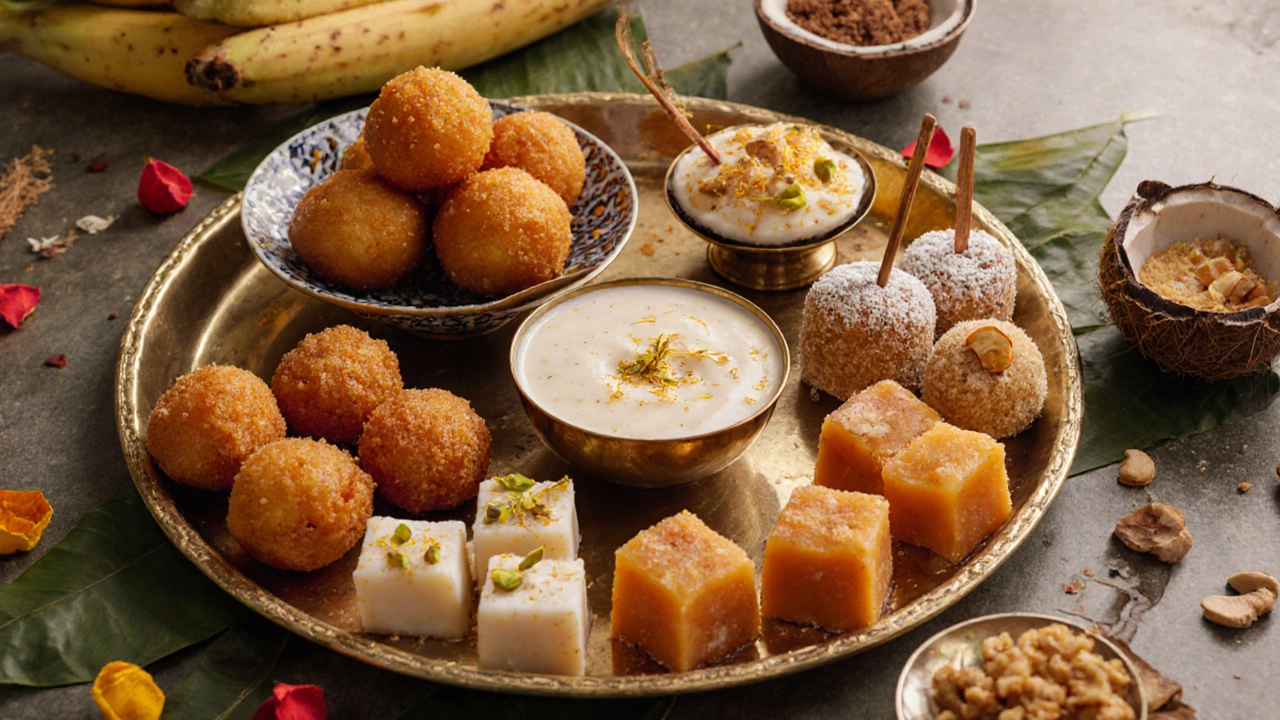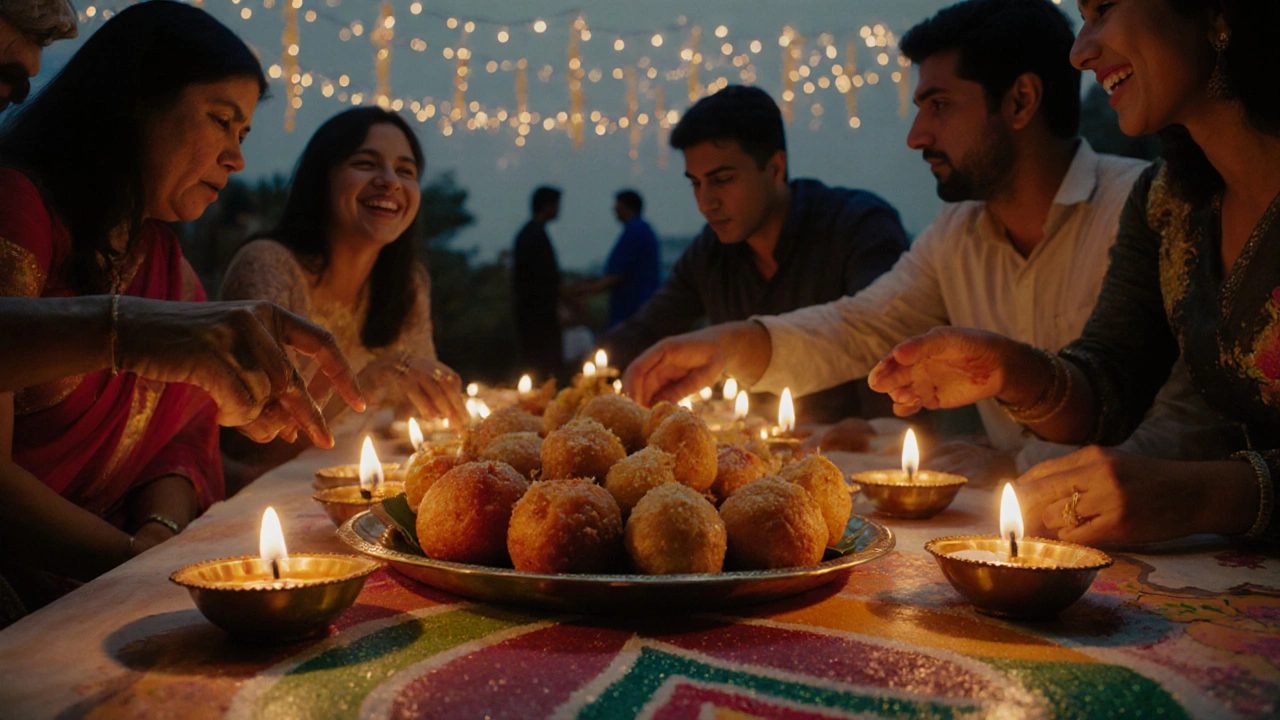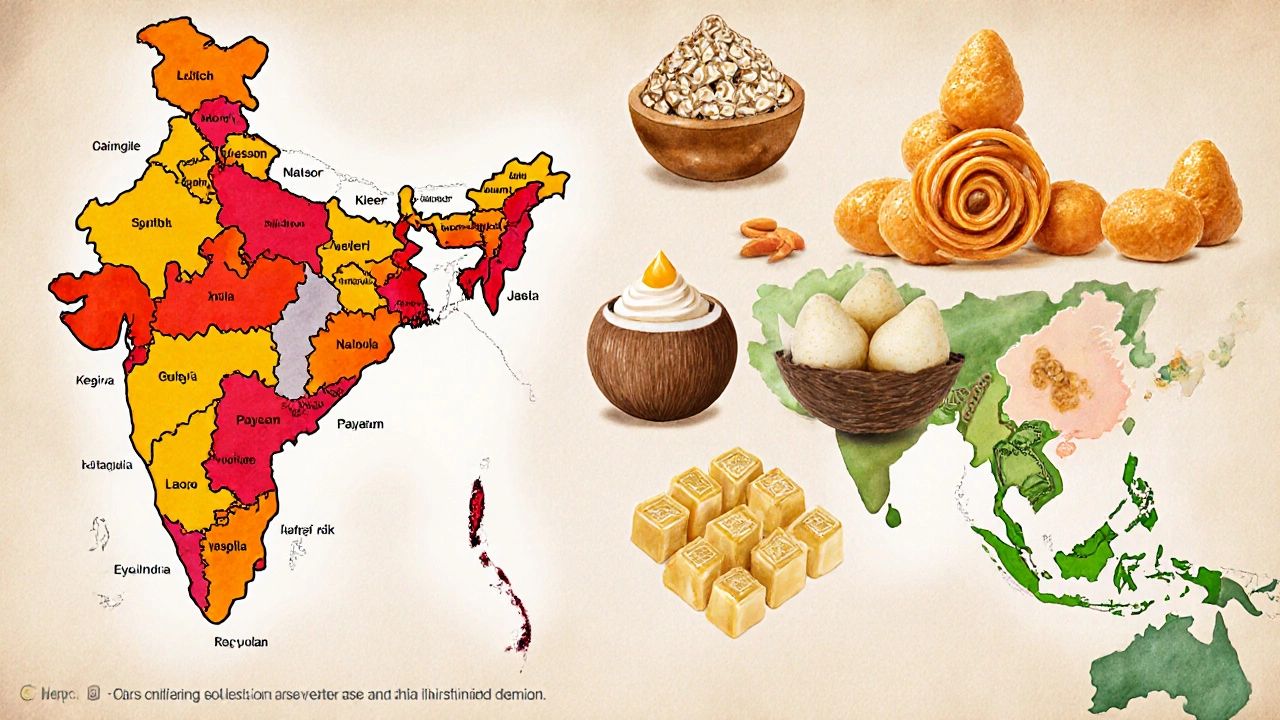26 Oct 2025
- 0 Comments
Indian Dessert Occasion Finder
Discover which traditional Indian desserts are served for specific festivals and celebrations. Select an occasion to see matching sweets.
Select an occasion from the list above to see relevant desserts.
When you think of Indian desserts a vibrant mix of flavors, textures, and regional quirks that have sweetened celebrations for centuries, you probably picture syrup‑soaked balls or golden, crispy spirals. But the reality stretches far beyond those classics - from chilled milky treats in the north to rice‑based delights in the south, each dessert tells a story about its home. In this guide we’ll explore the most beloved sweets, why they matter, and how you can bring a taste of India into your kitchen today.
How India’s Regions Shape Its Sweet Landscape
The subcontinent is a patchwork of climates, cultures, and culinary traditions. A dessert that dominates the streets of Delhi might be unknown in Kerala, while a coastal state’s favorite could be a staple at festivals in the mountains. Below is a quick map of the sweet spectrum:
- North India: Milk‑rich creations like Gulab Jamun, syrup‑drenched Jalebi, and creamy Kheer.
- West India: Sugar‑laden chews such as Barfi and the buttery, gram‑flour marvel Mysore Pak.
- South India: Rice‑based puddings like Payasam, coconut‑infused Kesari, and the crunchy Ladoo variations.
- East India: Light, spongy sweets such as Rasgulla and the delicate syrup‑kissed Sandesh.
Top 12 Must‑Try Indian Desserts
Below is a curated list of desserts you’ll encounter at festivals, street stalls, or family gatherings. Each entry includes a snapshot of its origins, key ingredients, and a simple home‑cook version.
-
Gulab Jamun
Soft, fried dough balls soaked in rose‑scented sugar syrup. Made from khoya (reduced milk solids) or milk powder, they melt in your mouth.
Quick recipe tip: Use a mix of milk powder, flour, and a pinch of baking soda for a fluffy texture. Fry on low heat, then simmer in sugar water flavored with cardamom and a few drops of rose water.
-
Jalebi
A pretzel‑shaped, deep‑fried coil that turns orange‑red after soaking in saffron‑infused syrup.
For a home version, pipe a batter of all‑purpose flour, yogurt, and a pinch of turmeric through a squeeze bottle into hot oil. After crisping, dip quickly in warm syrup.
-
Kheer
Rice cooked slowly in milk with sugar, cardamom, and nuts. It can be thick (South Indian style) or soupy (North Indian style).
Use basmati rice for a fragrant base, and stir constantly to avoid scorching. Finish with slivered almonds and a sprinkle of saffron.
-
Rasgulla
Spongy cheese balls (paneer) boiled in light syrup until they soak up the sweet liquid.
Press paneer into smooth discs, roll into spheres, and boil for about 15 minutes. Serve chilled - a perfect cooling treat on hot days.
-
Barfi
Dense milk‑based fudge, often flavored with pistachios, coconut, or rose.
Cook evaporated milk (khoya) with powdered sugar, stir until it leaves the sides of the pan, then press into a greased tray. Cut into diamond shapes.
-
Mysore Pak
Originating from Karnataka, this buttery confection combines gram flour, ghee, and sugar into a crumbly, melt‑in‑the‑mouth bite.
Whisk gram flour into hot ghee, add caramelized sugar syrup, and cook until the mixture pulls away from the pan. Let cool before slicing.
-
Ladoo
Round sweet balls made from various bases - from roasted gram flour (besan) to coconut, dates, or semolina.
Roast the chosen base with ghee, mix in powdered sugar and chopped nuts, then shape while warm.
-
Kulfi
A frozen dairy treat similar to ice cream but denser, often infused with cardamom, pistachio, or mango.
Blend milk, condensed milk, and flavorings, pour into molds, and freeze for at least 6 hours.
-
Payasam
South Indian rice or vermicelli pudding cooked with coconut milk, jaggery, and flavored with cardamom.
Combine cooked rice, coconut milk, and melted jaggery; simmer until thick, then garnish with cashews.
-
Kesari
A bright orange semolina (rava) halwa flavored with saffron and nuts.
Roast semolina in ghee, add water, sugar, saffron, and stir until glossy.
-
Sandesh
Delicate Bengali sweet made from fresh paneer, sugar, and often flavored with cardamom or rose.
Blend paneer with sugar, shape into squares, and chill.
-
Gajar ka Halwa
Grated carrots cooked with milk, ghee, and sugar, finished with nuts.
Slow‑cook carrots in milk, add ghee and sugar, and stir until the mixture turns golden.
When These Sweets Make Their Grand Appearance
Indian desserts are rarely just “after‑meal treats.” They are woven into religious festivals, weddings, and regional celebrations. Knowing the context helps you pick the right sweet for the occasion:
- Diwali: Gulab Jamun, Jalebi, and Kheer - symbols of prosperity and light.
- Rakhi: Sweets like Laddu are exchanged between siblings.
- Onam (Kerala): Payasam and Unniyappam are a must.
- Durga Puja (Bengal): Sandesh and Rasgulla dominate the sweet stalls.
- Wedding feasts: A mix of Barfi, Mysore Pak, and Kaju Katli (cashew fudge) line the dessert table.

Sourcing Ingredients: Tips for the Home Cook
Many Indian desserts call for specialty items like khoya, rose water, or ghee. Here’s how to get them without a trip to an Indian market:
- Khoya shortcuts: Reduce full‑fat milk on low heat (about 30 minutes) until it thickens, or buy pre‑made khoya at larger grocery stores.
- Rose water: Look for “food‑grade” rose water in the baking aisle or Asian section. A few drops go a long way.
- Ghee: Clarified butter is available in the dairy section; if not, melt unsalted butter and skim off the milk solids.
- Spices: Cardamom pods, saffron strands, and asafoetida (hing) are worth stocking - they define the flavor profile.
- Paneer: Fresh paneer can be made at home by curdling milk with lemon juice; it’s cheaper and fresher than store‑bought.
Quick Reference Table
| dessert | main ingredient | typical region | common occasion |
|---|---|---|---|
| Gulab Jamun | khoya / milk powder | North India | Diwali, weddings |
| Jalebi | flour batter | All over India | Ramadan, festivals |
| Kheer | rice & milk | North & South | Family celebrations |
| Rasgulla | paneer | East India | Durga Puja |
| Barfi | khoya | West India | Weddings |
| Mysore Pak | gram flour & ghee | South India | Onam |
| Ladoo | varies (besan, coconut) | All regions | Festivals, rituals |
| Kulfi | milk & condensed milk | North India | Summer treats |

Frequently Asked Questions
Which Indian dessert is the easiest for beginners?
Ladoo made from roasted gram flour (besan) is forgiving - you just need to roast the flour, mix with ghee and sugar, then shape while warm.
Can I make Indian sweets without ghee?
Yes. Substitute ghee with unsalted butter or a neutral oil, though the flavor will be slightly different. For dairy‑free versions, use coconut oil.
What’s the difference between barfi and kaju katli?
Both are milk‑based fudge, but barfi typically uses khoya and can include coconut or pistachio, while kaju katli is a smooth cashew‑nut paste flavored with cardamom and often cut into thin squares.
How long can I store homemade Gulab Jamun?
In the refrigerator, keep them in their syrup for up to 5 days. For longer storage, freeze the jamuns (without syrup) and re‑heat in warm syrup before serving.
Are Indian sweets always very sweet?
Not at all. Desserts like rasgulla or payasam rely on the natural sweetness of milk and jaggery, offering a milder profile. Adjust sugar levels to taste.
Next Steps: Bringing Indian Sweetness Home
Pick one dessert from the list, source the few key ingredients, and try the quick recipe tip provided. Once you’re comfortable, experiment with flavor twists - add orange zest to Gulab Jamun, or mix mango puree into Kulfi. Sharing these treats with friends will let you experience the cultural joy that’s been part of Indian celebrations for generations.
